#adnate
Photo

Work by Adnate and Jessica Crema in Greensboro, NC. Painted in 2017.
#adnate#jessicacrema#mural#art#greensboroart#urbanart#streetart#greensborostreetart#nc#northcarolina#gso#gsoart#greensboro#lumbee#nativeamerican#firstnations#greensboronc#impermanentart
44 notes
·
View notes
Photo

#Streetart by #Adnate @adnate in #Miami, Florida, USA, for #SurfaceFestival @surfacefestival Reference photo by @photography_by_black_cockatoo More info at: https://barbarapicci.com/2022/09/18/streetart-adnate-miami-florida-usa/ #streetartmiami #streetartflorida #streetartusa #usastreetart #art #graffiti #murals #murales #urbanart #muralism #muralismo #streetarteverywhere #instastreetart #streetartphotography #streetartpics #streetartaddicted #streetartlover #igersstreetart #graffitiart #arteurbana #wallart #spraypaint #spraypaintart #contemporaryart #artecontemporanea https://www.instagram.com/p/CisDWnioNO7/?igshid=NGJjMDIxMWI=
#streetart#adnate#miami#surfacefestival#streetartmiami#streetartflorida#streetartusa#usastreetart#art#graffiti#murals#murales#urbanart#muralism#muralismo#streetarteverywhere#instastreetart#streetartphotography#streetartpics#streetartaddicted#streetartlover#igersstreetart#graffitiart#arteurbana#wallart#spraypaint#spraypaintart#contemporaryart#artecontemporanea
7 notes
·
View notes
Text

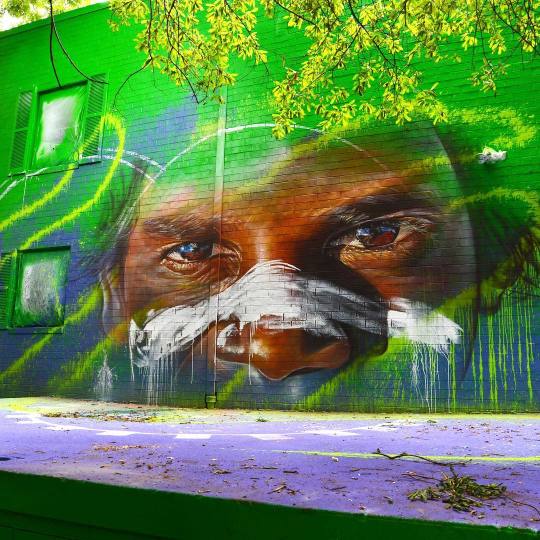


Australian artist @adnate Matt Adnate murals in Greensboro NC
#adnate#Matt Adnate#Mural#Greensboro#north carolina#Marty Kotis#art#street art#Australian#artist#street artist
0 notes
Text

Glory is fleeting, only fame is lasting.🎨
0 notes
Text
Hot siren gets her giant boobs and pierced cunt massaged
Mi amiga de Durango
Barranquillera
Japanese gf with long legs in pantyhose gets fucked
MinnieeXTC MILF se exibindo no Periscope
Young straight boy fucking clips and penis boys galleries gay
Senora piernas gruesas espiada
Please let me out of these handcuffs JOI
Skinny Japanese MILF amateur gets toyed and fucked
Desi Bhabi First Time Sex
#Sabuja#Isidora#Tungusic#geds#oppressing#studioghibliedit#Cousins#counter-party#Parthenolatry#conservations#giftedness#teazling#Begoniaceae#elatives#Zsolway#Ikaria#adnate#Mammut#priesting#unperfect
0 notes
Text
Scientists from four continents will gather at BHU in ADNAT 2023 conference
Varanasi: The ADNAT International Conference will be organized at the Mahamana Seminar Complex of Banaras Hindu University from March 10 to 12. In this conference, 21 world-renowned scientists from 15 countries of four continents (North America, South America, Europe and Asia will deliver lecture and conduct panel discussion.
The experts of Genetics, Personalized Medicine, Anthropology, Medical…

View On WordPress
0 notes
Text
FOTD #121 : tiny blue lights! (mycena lazulina)
tiny blue lights are little bioluminescent mushrooms in the family mycenaceae :-) there is not much known about them as they were only discovered in 2016, but so far they have been documented in southwestern japan !! they are also saprotrophic (feed on dead organic matter).
the big question : can i bite it??
the edibility is unknown thus far. ^^"


m. lazulina description :
"tiny blue lights are small & bioluminescent. the have the following traits : gills on hymenium, cap is convex, hymenium is adnate, stipe is bare. the cap is light blue to white, the gills are white & the stipe changes from white to dark blue down the length. visually, it appears as if dusted with sugar."
[images : source & source]
[fungus description : source, which was pieced together by me !!]
#• fungus of the day !! •#[mycena lazulina]#: tiny blue lights :#121#||#mushroom#mushrooms#mycology#earth#nature#cottagecore#fungus#forestcore#foraging#fungi#mycena lazulina#tiny blue lights#fotd#fungus of the day
768 notes
·
View notes
Photo
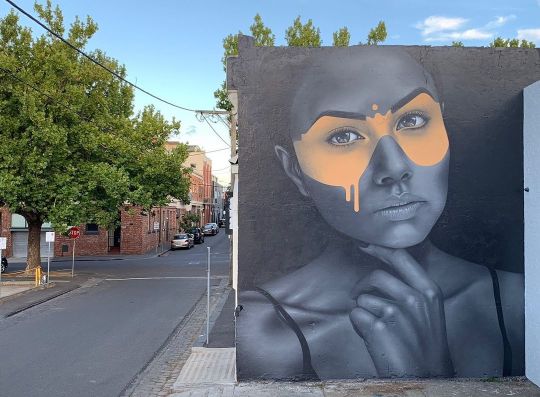
Working on some one-off print versions of this ‘Unukausay’ artwork (featuring @avadavid_) in the new space this week. - Painted in Fitzroy, Melbourne in 2019 with some leftover paint given to me by @adnate and with plenty of support from @mike.makatron and @everfreshstudio (a very welcoming and supportive team of people). - The original studio interpretation was included in my 2021 solo show but there are plans afoot for a full simultaneous release of this and another similar artwork later this year 🤗. - #findac #urbanaesthetics #urbanart #streetart #artonwalls #art #mural #muralism #arts #artist #artists #artistic #painting #portrait #artoftheday #artwork #artworks #urbancontemporaryart #artlife #urbancontemporary #portraitpainting #artdaily #artstagram #artistsoninstagram #artistsofinstagram #artoninstagram https://www.instagram.com/p/CohAHx9ohp6/?igshid=NGJjMDIxMWI=
#findac#urbanaesthetics#urbanart#streetart#artonwalls#art#mural#muralism#arts#artist#artists#artistic#painting#portrait#artoftheday#artwork#artworks#urbancontemporaryart#artlife#urbancontemporary#portraitpainting#artdaily#artstagram#artistsoninstagram#artistsofinstagram#artoninstagram
97 notes
·
View notes
Photo

Work by Adnate and Jessica Crema in Greensboro, NC. Painted in 2017.
#adnate#jessicacrema#tuscarora#nativeamerican#firstnations#montanacans#mural#art#greensboroart#urbanart#publicart#streetart#greensborostreetart#lumbee#streetartphotography#streetarteverywhere#streetartdaily#streetartandgraffiti#arteurbano#artecallejero#greensboro#gso#greensboronc#nc#northcarolina#impermanentart#ontour
12 notes
·
View notes
Text

Streetart by Adnate @ Darwin, Australia, for Darwin Street Art Festival
More info at:
https://barbarapicci.com/2023/10/11/streetart-adnate-darwin-australia/
18 notes
·
View notes
Text
How to Identify Late Oyster Mushrooms
Click here to learn more about the How to Identify article series.
Name: Late oyster mushrooms (Sarcomyxa serotina)
Range and typical habitat(s): North American west, United States east of the Great Plains, widespread across Europe, extreme east Asia
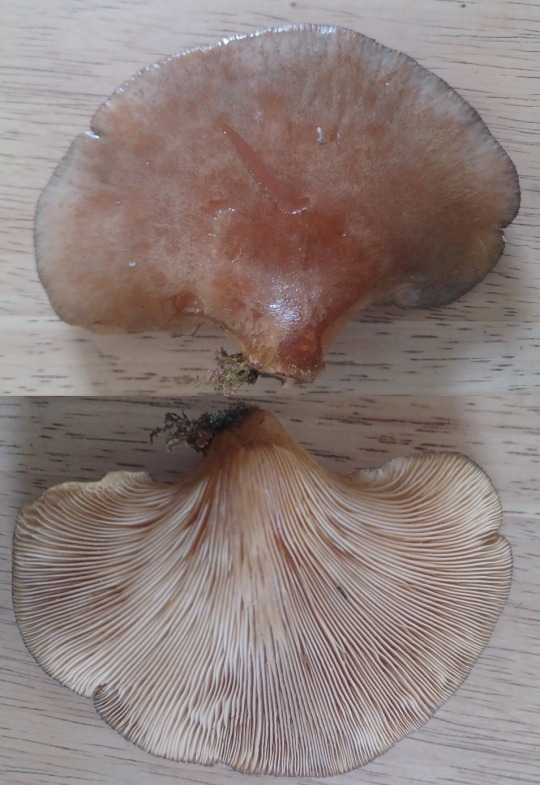
The top and underside of a late oyster mushroom.
Distinguishing physical characteristics (size, colors, overall shapes, detail shapes): At first glance the this looks like any other oyster mushroom, with its round, shelf-shaped appearance. However, where true oysters (Pleurotus spp.) tend to be gray or white in appearance, the slimy-textured cap of the late oyster can be anywhere from orange to olive-green to violet-tinted, and can grow up to six inches across. The gills are usually yellow to orange, and while some may remain single from the stipe to the edge of the cap, others fork at least once.
Young late oyster mushrooms may have edges that roll under, but when mature they open to a flatter shape, sometimes with a gently scalloped edge. The stipe is quite unique with its fuzzy texture, and is generally very short. The tightly-packed gills are adnate, meaning that they attach to the stipe with their entire width, rather than becoming shorter in height as they approach the stipe. Take a spore print of a late oyster mushroom, and you’ll find a cream to yellow print. The flesh does not bruise or otherwise discolor when damaged.
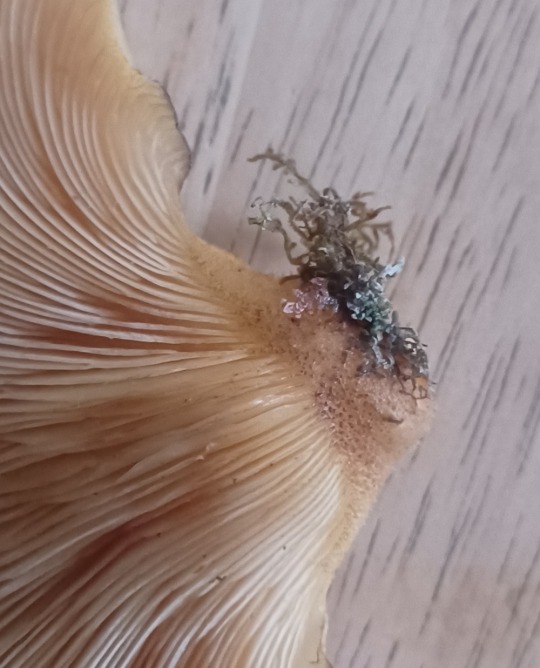
Notice the texturing on the stipe of this late oyster mushroom.
Like oyster mushrooms, late oysters grow in clusters on decaying hardwood trees, like maples and alders. They gain their “late” name for their tendency to fruit in fall to early winter; October to December is prime time for this fungus. Even in areas that receive frosts and freezes, the mushrooms may keep on growing in spite of the cold.
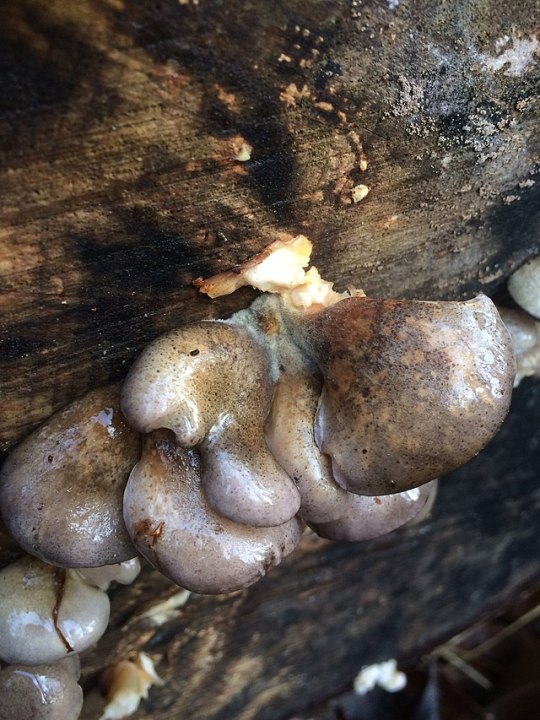
Other organisms it could be confused with and how to tell the difference: Again, true oyster mushrooms bear the most resemblance to late oysters. In addition to being less colorful–gray to white being most common–true oysters have a smooth rather than fuzzy stipe. Their spore print is usually white, occasionally with a slight purple tint. Finally, the gills of true oysters continue down the stipe (decurrent), while the late oyster’s gills stop at the stipe.
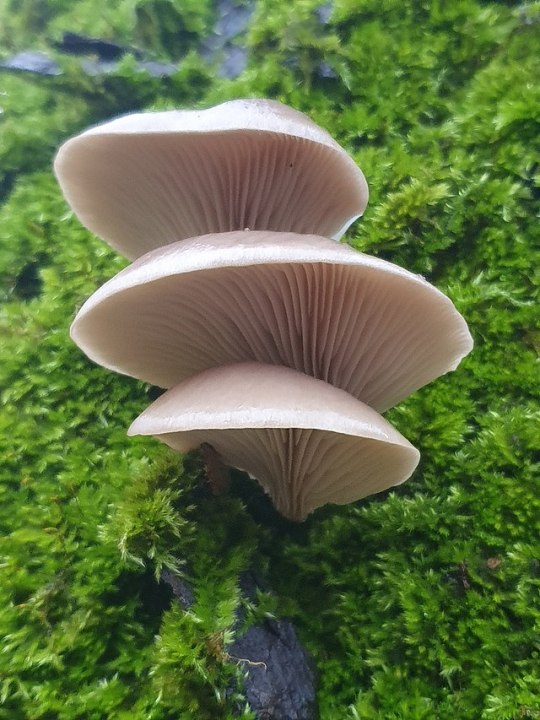
Oyster mushrooms (Pleurotus ostreatus)
Angel wing mushrooms (Pleurocybella porrigens) are another white mushroom found growing on dead wood. They lack the late oyster’s color variety and have decurrent gills that produce white spores, and their flesh tends to be more delicate. Most importantly, angel wings grow on decaying conifers while late oysters grow on hardwood trees, and they fruit in late summer into fall, but not to winter. Angel wing mushrooms used to be considered edible, but a series of poisonings several years ago has put their edibility into question.

Angel wing mushrooms (Pleurocybella porrigens)
Shoehorn oyster mushrooms (Hohenbuehelia petaloides) may sometimes look a bit like a brown-tinted late oyster mushrooms, but look underneath and you’ll see the white gills are decurrent, and they have a white spore print. Also, they tend to grow on woody debris rather than tree trunks, and will fruit anywhere from spring through fall.

Shoehorn oyster mushrooms (Hohenbuehelia petaloides)
The only other significant inedible lookalike besides angel wings is the mock oyster (Phyllotopsis nidulans). The orange cap may look similar to an orange-colored late oyster, but it has a fuzzy texture all over instead of only on the stipe. The gills produce orange to peach spores, are decurrent, and not as tightly packed as on the late oyster. A strong stench is the best way to identify the mock oyster, and should you try eating one it has an equally unappealing flavor and tough texture.
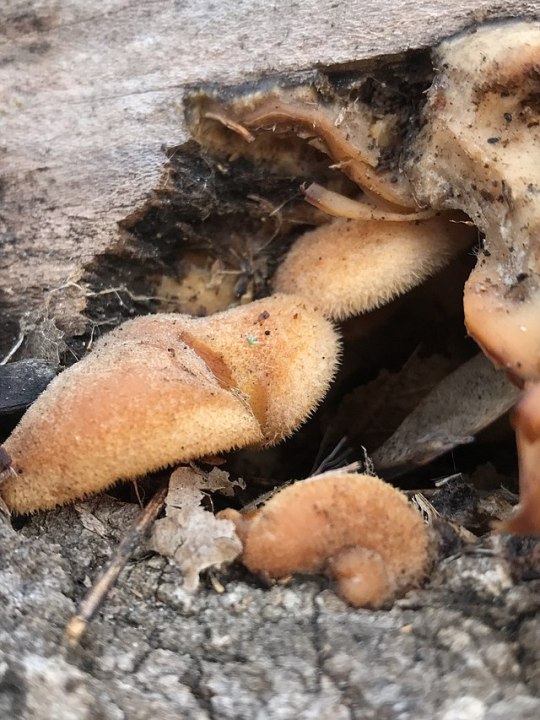
Mock oyster mushrooms (Phyllotopsis nidulans)
Anything else worth mentioning? Late oyster mushrooms are considered edible, though with a rather bland, unexciting flavor. Their texture is good, though, and they lend themselves well to being vehicles for sauces and other flavoring agents. Some people report they can be bitter if the top layer is not peeled off, and it is strongly recommended that they be cooked longer than some other mushrooms, at least 15-20 minutes. This can reduce the chance of gastrointestinal upset, but as always it is best to only try a very small amount of a new mushroom when eating it for the first time, and you MUST make absolutely sure you are 100% certain that what you are about to eat is an edible species.
Further reading:
Late Fall Oyster: Identification, Foraging, and Preparing
Late Fall Oyster Mushrooms: Sarcomyxa serotina
Late Fall Oyster (Panellus serotinus) — Identification & Medicinal Benefits
Late Fall Oyster: Sarcomyxa serotina
Did you enjoy this post? Consider taking one of my online foraging and natural history classes or hiring me for a guided nature tour, checking out my other articles, or picking up a paperback or ebook I’ve written! You can even buy me a coffee here!
#late oyster mushrooms#oyster mushrooms#edible mushrooms#edible fungi#foraging#mushroom foraging#mushroom hunting#shrooms#fungi#fungus#mycology#nature identification#nature#ecology#food#wild foods
18 notes
·
View notes
Text

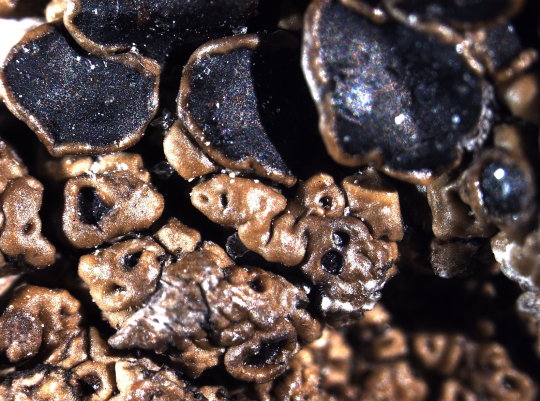







Protoparmelia badia
This crustose lichen has a confusingly variable thallus that can be granulose, wart-like, areolate (tile-like), or subsquamulose (almost scale-like) or a combination of these or something in between. She defies classification. It is typically large (up to 10 cm in diameter), and the thallus varies in color from whitish to shades of brown to shades of green to shades of yes, even gray. It can be surrounded in a thin, black prothallus, but not always. The apothecia are likewise confusing, varying in shape and size, and can appear immersed, sessile (sitting directly on the thallus surface) or adnate (sitting on short, constricted base). To top it all off, the disc color is also variable, but typically sticks to shades of brown. So how are you supposed to identify this little MFer? Luckily it has distinctive spindle-shaped ascospores, and contains lobaric acid and zeorin, so with a bit of lab work, it can be known. P. badia colonizes hard, exposed siliceous rock in montane and arctic-alpine areas of North America, South America, Europe, Asia, Australasia, and Antarctica.
images: source | source | source
info: source | source | source | source
#lichen#lichens#lichenology#lichenologist#lichenized fungus#fungus#fungi#mycology#ecology#biology#botany#bryology#symbiosis#symbiotic organisms#algae#Protoparmelia badia#Protoparmelia#trypo#trypophobia#tw: trypophobia#life science#environmental science#natural science#science side of tumblr#nature#naturalist#beautiful nature#weird nature#lichen subscribe#I'm lichen it
29 notes
·
View notes



